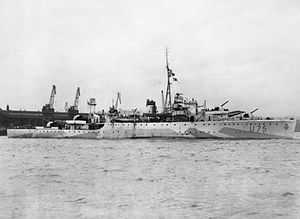HMS Egret (L75)
 HMS Egret (L75) | |
| Career (United Kingdom) | |
|---|---|
| Name: | HMS Egret |
| Builder: | J. Samuel White of Cowes, Isle of Wight |
| Launched: | 31 May 1938 |
| Identification: | pennant number: L75 |
| Fate: | Sunk 27 August 1943 |
| General characteristics | |
| Class and type: | Egret-class sloop |
| Displacement: | 1,200 tons |
| Length: | 276 ft (84 m) |
| Propulsion: | Geared steam turbines on two shafts 3,600 shp (2,700 kW) |
| Speed: | 19.25 knots (35.65 km/h; 22.15 mph) |
| Complement: | 188 |
| Armament: | 8 × 4-inch AA guns (4 × 2) 4 × .5-inch AA (1 × 4) |
HMS Egret was a sloop of the British Royal Navy, the lead ship of her class. She was built by J. Samuel White at Cowes, Isle of Wight and was launched on 31 May 1938.
Egret was the first ship ever to be sunk by a guided missile. The Germans had used the Henschel Hs 293 glider bomb for the first time on 25 August 1943 against the 40th Support Group in the Bay of Biscay. Landguard was slightly damaged by a near miss. Bideford was hit and damaged, with one sailor killed, though more serious damage was avoided because the bomb's explosive charge did not fully detonate.
On 27 August 1943 the 40th Support Group was relieved by the 1st Support Group, consisting of Egret together with the sloop Pelican and the frigates Jed, Rother, Spey and Evenlode. The group was attacked by a squadron of 18 Dornier Do 217 carrying Henschel glider bombs. One of the two covering destroyers, HMCS Athabaskan, was heavily damaged by a bomb and Egret was sunk with the loss of 194 of her crew.[1] At the time there were four RAF Y-Service electronics specialists on board, all of whom also died in the attack, thus bringing to total killed to 198. (These four RAF personnel are typically excluded from published casualty figures.) Egret had been fitted with electronic surveillance equipment designed to monitor Luftwaffe bomber communications and these Y-Service technicians were aboard to operate this equipment. The other destroyer, Grenville, commanded by Roger Hill, was attacked by the Dorniers firing one missile at a time but survived by being able out-turn the bomb.[2]
Egret 's sinking led to the anti-U-boat patrols in the Bay of Biscay being suspended.[3]
Notes
- ↑ HMS Egret (L 75 / U 75)
- ↑ Roger Hill (1975). Destroyer Captain. pp. 116–121. ISBN 0718300947.
- ↑ Milner, Marc (1994). The U-boat hunters: the Royal Canadian Navy and the offensive against Germany's submarines. University of Toronto Press, p. 57
References
- Colledge, J. J.; Warlow, Ben (2006) [1969]. Ships of the Royal Navy: The Complete Record of all Fighting Ships of the Royal Navy (Rev. ed.). London: Chatham Publishing. ISBN 978-1-86176-281-8. OCLC 67375475.
- Maj. Sim, Stephen (October–December 1998), "The Anti-Ship Missile – A Revolution in Naval Warfare", Pointer 24 (4), retrieved 16 April 2007